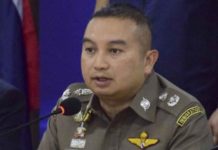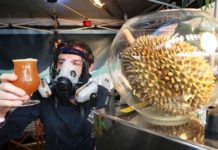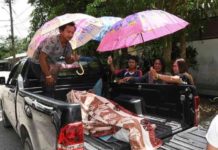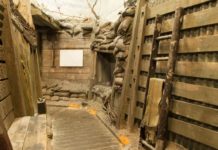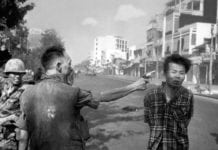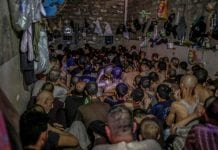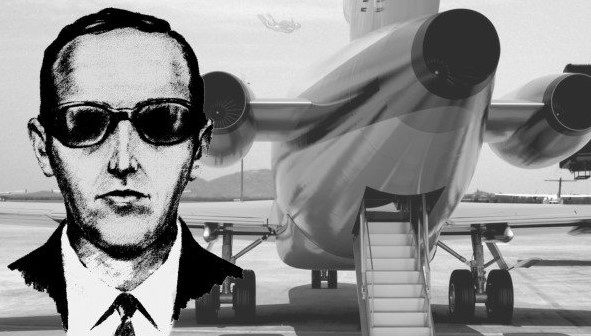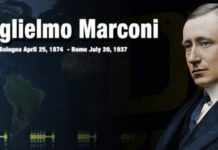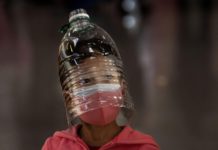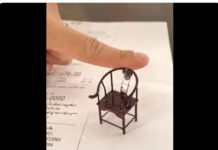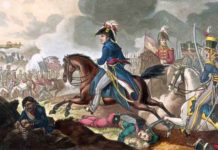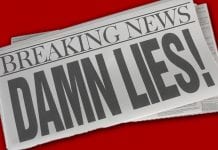What happened to famous hijacker who jumped off a plane and into thin air carrying a fortune in banknotes?
The offence on the face of it was a simple one, but the mystery surrounding its aftermath has passed into legend.
On 24 November 1971, a man going by the name of D. (‘Dan’) B. Cooper hijacked a Boeing 727 on a domestic flight and demanded $200,000 from its owners, Northwest Orient.
Confident they would catch the hijacker, the company agreed to pay the cash in exchange for their passengers.
But the hijacker had other plans. After the aircraft had taken off again, minus its passengers and with D. B. Cooper $200,000 richer, he strapped himself to a parachute and jumped out into the cold night.
He was never seen or heard of again, so if he survived the jump, it had been the perfect crime.If not, of course, he had been the perfect idiot.
Either way, D. B. Cooper became an instant celebrity among the tie-dyed, hash-smoking hippies of the early 1970s, when hijacking had rather more of a romantic/revolutionary feel about it than it does today when terrorists are suspected at every turn.
Despite one of the biggest manhunts in American history, including amateur investigations, books, TV documentaries and films, nothing more is known about D. B. Cooper today than was known on the day of his daring, airborne stunt.
So let’s look at the events in a bit more detail. At 4 p.m. on that particular day in 1971 – the fourth Thursday in November, Thanksgiving Eve – a soberly dressed businessman approached the counter of the Northwest Orient Airline at Portland International Airport and bought a one-way ticket to Seattle for $20.
The businessman, who gave his name as D. B. Cooper, was allocated seat 18C on Flight 305, which left on time at 4.35 p.m., climbing into the cold, rainy night with thirty-seven passengers and five flight crew on board.
Shortly after take-off, the passenger sitting in seat 18C beckoned to an attractive young stewardess, Florence Schaffner, and passed her a note. This was such a common occurrence between businessmen and the flight crew that Schaffner, believing Cooper had given her his phone number, simply smiled and placed it, unread, in her pocket.
The next time she passed seat 18C, Cooper whispered, ‘Miss, you had better read that note. I have a bomb.’ She duly read the note and rushed to the cockpit to show Captain William Scott.
The captain then instructed Schaffner to walk to the back of the plane and, so as not to alarm the other passengers, quietly sit next to Cooper and try and gather more information.
As she sat down, the hijacker opened his briefcase and wordlessly revealed a device consisting of two cylinders surrounded by wires. It certainly looked like a bomb to the young stewardess.
Captain Scott then radioed air traffic control with Cooper’s demand of $200,000 in used notes, together with four parachutes; two for him and the others for two of the crew he intended to take with him as hostages.
The FBI were alerted and ordered Northwest Oriental’s president, Donald Nyrop, to comply fully with Cooper’s demands. After all, they reasoned, where was he going to go? No one could survive jumping from a jet passenger airliner and survive.
There was also the safety of the other passengers to consider, together with the negative publicity such a hijacking would generate if the company refused to comply; Nyrop felt $200,000 was a small sum to pay in the circumstances.
Cooper then instructed the pilot to stay in the air until the money and parachutes were ready, and soon heard Captain Scott announce to his passengers that a small mechanical problem would require the jet to circle before landing.
The rest of the passengers remained unaware of the hijacking and Flight 305 finally landed at 5.45 p.m. at its intended destination.
Once Cooper was satisfied that the money, all in used $20 notes, and the parachutes had been delivered, he allowed the passengers to leave. At 7.45 p.m., with only the pilot, co-pilot, flight attendant and himself remaining on board, Cooper told Captain Scott to fly towards Mexico.
He instructed him to fly at a low altitude of 10,000 feet (instead of the usual 30,000 feet), and with its landing gear down and the wing flaps set at fifteen degrees, thus indicating a detailed knowledge of flying.
Unknown to him, however, the plane was being closely tracked by two United States Air Force F-106 jet fighters, using a state-of-the-art radar detection system.
As the flight crossed southwest Washington, Cooper then ordered the pilot to slow his speed to 150 knots and the rest of the crew to remain at the front of the plane with the curtains closed.
At 8.11 p.m. the rear door warning light came on and this was the last anyone saw of the mysterious D. B. Cooper. Even the air force pilots shadowing Flight 305 in their jet fighters failed to see him jump.
After landing safely in Mexico at Reno airport, the intended destination, the crew waited in the cockpit for ten minutes for further instructions. None came and air traffic control also confirmed they had not received any instructions from Cooper.
Cautiously Captain Scott called the hijacker over the intercom and, on receiving no response, nervously opened the cockpit door. Cooper had vanished, having taken everything with him, including his briefcase bomb, the canvas bag full of $20 notes, his hat and coat.
All that remained were the three unused parachutes. Cooper had done the unthinkable. He had jumped out of a commercial passenger jet and into the cold, wet night, thousands of feet above the ground. He had completely disappeared, never to be seen again.
Nobody could prove he had survived and therefore got away with his crime, but, as even the FBI admitted, nobody could prove he was dead either.
The FBI calculated that the likely landing area for the skydiving hijacker was southwest of the town of Ariel, close to Lake Merwin, thirty miles north of Portland, Oregon.
The eighteen-day manhunt that followed failed to reveal a single trace of the hijacker, but then all the FBI had was a description of a fit, six-foot, olive-skinned man, of Mediterranean appearance, clean shaven and wearing a dark suit, which narrowed the search right down to about a billion people, worldwide. They had some work to do.
It was soon apparent to the authorities that they were dealing with a meticulously planned crime, well thought out in every detail. First of all, Cooper had had no intention of taking any hostages with him: his request for four parachutes was simply to ensure that no dummy parachutes were delivered.
Cooper had also worked out the weight of the ten thousand $20 notes as twenty-one pounds. If he’d asked for smaller denominations, they would have weighed considerably more and created a risk when landing, while larger denominations would be harder to pass on, thereby creating a risk of being caught. Hence $20 bills were perfect for Cooper’s purposes.
He also knew that the Boeing 727-100 has three engines, one high on the fuselage immediately in front of the vertical tail fin and two others on either side of the fuselage just above the horizontal tail fins.
This meant that neither the engine exhausts nor the intakes would get in the way when he lowered the rear steps and threw himself out into the night, which led to speculation he had targeted Flight 305 specifically for its engine layout.
Cooper also insisted the pilot did not pressurize the cabin, knowing he would be able to breath naturally at 10,000 feet (but no higher) and reducing the risk of air rush as the door was opened.
And as he was fully aware of the 727’s minimum flight speed with a full load of fuel, as well as the wing-flap settings required, and appeared to know that the 1,600 mph F-106 fighters would no longer be able to escort the jet once the aircraft speed had reduced to around 150 knots, this gave Cooper the window of time he needed to jump unseen, suggesting to many he was either a serving or retired airman.
The only mistake he made was to leave behind eight Raleigh cigarette stubs, his tie and tie pin, but even this evidence has led the police nowhere. There were also sixty-six fingerprints on the plane that could not be matched to the flight crew or any of the other passengers.
Considering the number of people travelling on a commercial airliner in the course of a few weeks, this was regarded as unreliable evidence, although an exhaustive check with FBI records revealed no match anyway and D. B. Cooper’s real identity remained unknown.
That he could recognize McChord Air Force Base as the Boeing 727 circled Seattle–Tacoma airport also provided a clue, as did his lack of a regional accent observed by the ticket agent who allocated his seat.
This all led FBI investigators to conclude Cooper was local and with a background in either military or civil aviation, possibly from McChord Air Force Base itself.
Appalling weather the day after the hijacking interrupted the search through the vast wooded area Cooper had probably landed in. But the full-scale land and air search that took place over the ensuing weeks revealed no trace of Cooper, the distinctive red and yellow parachute or, most importantly, the cash.
The police search team did discover the body of a missing teenager but Cooper himself had vanished, which seems to disprove the theory he had been killed during the jump or on landing.
The FBI even checked the national database for any criminal by the name of Dan Cooper, or D. B. Cooper, in order to find out if, on the off chance, this otherwise meticulous and thorough hijacker had been stupid enough to buy a ticket in his own name.
He wasn’t, although a genuine Dan Cooper in Portland did receive an uncomfortable few hours of questioning before being released without charge.
The FBI circulated a wanted poster throughout the States, with an artist’s impression of Cooper based upon witness accounts, but it could have been a picture of just about every average American on the street and as many as ten thousand false sightings were reported.
As it was, the FBI interviewed over 1,400 people, but to no avail. The story held the popular imagination for a long time, the newspapers ridiculing the unsuccessful FBI investigation in the process.
Eventually the hijacker, named as ‘John Doe, aka Dan B. Cooper’ was charged, in his absence, with air piracy at a federal court in 1976. (John Doe is the generic name America gives to persons, or bodies, unknown; for instance, unclaimed raffle-tickets are listed as belonging to ‘John Doe’ until claimed.)
The American public, on the other hand, was in the process of elevating D. B. Cooper to the status of a legend as the mystery around him continued to grow.
Bars in the area of Ariel and Lake Merwin set up D. B. Cooper shrines, which remain to this day, and hold D. B. Cooper ‘days,’ with local parachute clubs even re-enacting the jump on the day before Thanksgiving every year.
That is what we all like most about this sort of history. Nobody was hurt, it involved extraordinary courage and nothing has been found since. Not even Cooper’s hat, coat and briefcase.
And that is why we all want Cooper to still be alive, and not to have been lying at the bottom of Lake Merwin all these years. We like the idea of Cooper jumping out of a passenger jet with the loot, landing and then dusting himself off, picking up his briefcase, putting on his hat, pausing only to straighten its brim, and being back in the office by nine.
But the FBI do not share our warmth towards the mystery man. Agent Ralph Himmelsbach spent eight years at the head of the investigation and was unable to hide his bitterness, calling Cooper a ‘dirty rotten crook,’ a ‘rodent,’ and nothing more than a ‘sleazy, rotten criminal who threatened the lives of more than forty people for money,’ oh – and ‘a bastard.’
Himmelsbach once snapped at a journalist who enquired about Cooper’s growing status as a hero. ‘That’s not heroic,’ he shouted. ‘It is selfish, dangerous and antisocial. I have no admiration for him at all. He is not admirable. He is just stupid and greedy.’
Himmelsbach retired from the FBI in 1980, his work incomplete, to run his own charm school in the Deep South. In his subsequent book, Norjack – The Investigation of D. B. Cooper, Himmelsbach tried to promote what is known as the ‘splatter’ theory, meaning Cooper had been killed as he hit the ground.
This is dismissed by most, as the body, highlighted by its bright red and yellow parachute, would have turned up sooner or later.
When pressed by reporters about why the body had not been found despite a legion of police, the Army Reserve, volunteers and boy scouts all searching, Himmelsbach surprised everybody, including, I imagine, the FBI, when he insisted they had all been looking in the wrong area all the time, despite the Feds re-enacting the jump in an effort to pinpoint Cooper’s drop zone.
In 1980 an eight-year-old boy was playing by the river and discovered a bag of cash totalling $5,800, all in $20 notes. His father, aware of the D. B. Cooper mystery, immediately took the cash to the police, who checked the serial numbers and confirmed this was part of the missing money.
Hopes of a conclusion were dashed on discovering the cash was found nearly forty miles upstream of where the police now believed Cooper to have landed. As did the geologists who claimed, having studied the notes and assessed their rate of deterioration, that the money must have been placed in the water in about 1974, three years after the hijacking.
Despite these discrepancies, Himmelsbach considered this evidence proved his splatter theory. He claimed Cooper must have landed in the lake on that dark night and drowned. But the resulting search by scuba divers with modern sonar equipment failed to find any further clues.
Few people outside the FBI believe this theory. Instead many believe Cooper’s careful plan included dropping a few bags of money at a later date to serve as a red herring. It would appear that Cooper had thought of everything, which is why he is probably still at large.
The hijacker had a further stroke of luck when on 18 May 1980 the volcano near the site of his purported landing, Mount St Helens, erupted with such force that the landscape was changed for ever, no doubt concealing many undiscovered clues.
But there is, however, one more important piece of evidence for us to consider.
In 1972 an embarrassed FBI produced a thirty-four page booklet detailing the crime and, more importantly, including photographs of the money and listing every single serial number of the ten thousand notes.
The booklet was sent to every bank and financial institution in America, with copies to the national media.
But, despite rewards on offer of up to $150,000 for the production of just one solitary note, none have ever turned up in the American system (with the exception, that is, of the $5,800 discovered in the water). Like Cooper, they have simply vanished.
But this fact alone does not mean Cooper is dead, as most countries around the world, especially developing nations, trade in dollars and so the money could have turned up anywhere.
The police expected at least one to have turned up somewhere over the years, and that leaves investigators even more baffled. For nothing to have been seen or heard of Cooper, dead or alive, nor for a single bank note to have reappeared, is hard to imagine. And yet this quite literal vanishing into thin air is exactly what did happen.
The problem about the carrying out the perfect crime is that then everyone wants to try it too. The following year produced no fewer than four copycat jumps and although one, the first effort, did end in a splatter landing, the following three hijackers all landed safely but were arrested at the scene or soon afterwards.
Then there was a new and interesting development. On 7 April 1972, four months after the Cooper hijack, a man checked in as James Johnson on United Flight 855 travelling from Newark to Los Angeles. J
ust after take-off, Johnson put on a wig, fake moustache and sunglasses and gave the stewardess a note. This read:
Land at San Francisco International Airport and taxi to Runway 19 Left [a remote part of the airport].
Send for a refuelling truck, but no other vehicles must approach without permission.
Direct United Airlines to provide four parachutes and a ransom of $500,000 in cash.
The captain carefully followed the instructions and the aircraft was soon back in the air again, this time heading for Provo in Utah. After an hour and a half, Johnson instructed the captain to reduce altitude, speed and depressurize the cabin, in a carbon copy of Cooper’s plan.
Except that a co-pilot glanced around the cockpit door just in time to see Johnson expertly slip on the parachute, open the rear door and jump.
The FBI started their investigation the minute the aircraft landed at Provo. This time they had a cast-iron clue. Johnson had left a single, clear fingerprint on an in-flight magazine.
They were initially baffled as Johnson had no criminal record and no match was found for the print. But then they had a breakthrough. In a telephone call to the FBI in Salt Lake City, a young man gave the police the detailed plan of the hijacking, including details not yet made public.
He claimed his friend Richard McCoy Jr had boasted about the plan to him, and the preparatory details he described were in fact identical in every way to those of the hijacking of Flight 855.
McCoy was twenty-nine years old, married with two young children and studying law at Brigham Young University. He was also a Vietnam veteran, former green beret helicopter pilot and specialist parachute trooper.
The FBI checked his service fingerprint record and found an exact match to the print found on the plane. The handwriting on the ransom note also matched McCoy’s samples in his military file. This time they had their man.
Two days later, McCoy was arrested at his home where police found a parachute suit and a bag of cash containing $499,970. The FBI asked the trial judge to make an example of McCoy to deter further copycat hijackings and the young man received a sentence of forty-five years without parole.
But within months he had escaped from prison. He was eventually tracked to a house in Virginia Beach, where he was shot dead during the ensuing gun battle to re-arrest him.
The similarities between the two crimes, in particular the evident flying expertise in each case, led to speculation that McCoy himself was in fact D. B. Cooper, and certainly the tie left behind by Cooper was similar to McCoy’s Brigham University tie.
It seems pretty unlikely, though: how would the D. B. Cooper money turn up in the river two years after McCoy’s death, for instance? Although it might explain why no money ever re-entered the system, as McCoy may have stashed it away for the future and it has remained hidden ever since.
The truth is that the identity of D. B. Cooper remains a mystery and each year the American media remind the public by way of anniversary articles and features, although to this day nobody has ever produced a credible theory, backed up with indisputable evidence, as to the identity or whereabouts of either Cooper or the money. – Albert Jack
Albert Jack AUDIOBOOKS available for download here
Albert Jack’s Mysterious World




